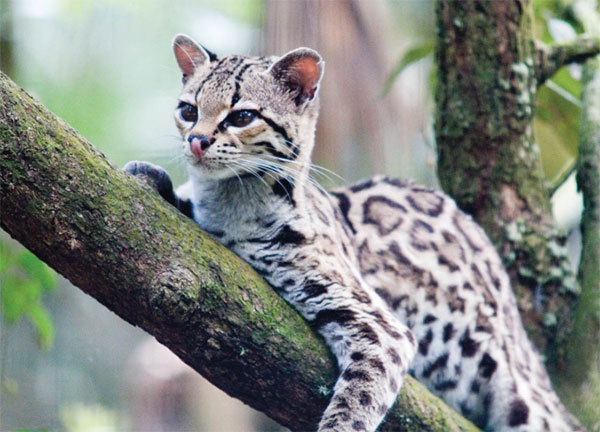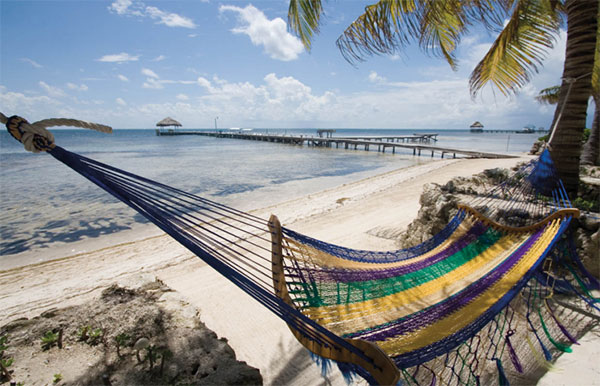BELIZE ZOO
There is one place in Belize where you can be sure of seeing the country’s most special creatures in a natural setting.
What many people fail to realize when they come to Belize is that their chances of seeing the larger land animals are limited. The tangle of vines and thick foliage makes it difficult to see even a few feet off a forest path or road. Also, many tropical creatures are nocturnal, finding safety under the cloak of night. Except for a flash of fur dissolving into the bush, or the snap of branches and rustle of leaves, most visitors will end up experiencing the habitat where wildlife live instead of viewing the creatures themselves.
But there is one place where you are assured of seeing a jaguar or a tapir in a natural setting. Belize Zoo (www.belizezoo.org; Mon–Sat 8.30am–5pm, 8.30am–4.30pm Sun) is an oasis of ponds, forests, and flowers among the sprawling savannas 47km (29 miles) west of Belize City. More than 60 Indigenous Belizean animals live here in large, natural enclosures.
If you can, try to visit the zoo first thing in the morning or late in the afternoon, when the animals are more active. You will often feel that you are in the forest, peering through a tangle of vines and shrubs to catch a glimpse of a puma, jaguarundi, or ocelot. Patience and persistence are necessary to view the creatures here, but your patience will be rewarded: a glimpse of a jaguar staking out his dominion, time in the company of curious and lively kinkajous, or eye-to-eye contact with the towering jabirú stork. Other star attractions include a pair of harpy eagles, the largest eagles in the world, which are nearly extinct in Central America. They are an awesome sight, and of great conservation importance.

A margay cat, or ‘tiger cat,’ at Belize Zoo.
Corrie Wingate/Apa Publications
There’s also a reptile area where you can see Belizeans snakes, including the very venomous fer-de-lance and the boa constrictor. The Belize Zoo education programs concentrate on informing visitors about snakes and their beneficial role in the ecosystem, helping to control rats and other rodents.
An environmentally-friendly habitat
The animals and grounds are meticulously cared for, and fun signs spell out the natural habits of each animal and its endangered status, reminding visitors that ‘Belize is my home too!’ Raised gravel paths lead from exhibit to exhibit through natural savanna and pine ridge vegetation, as well as transplanted rainforest. Belize Zoo is as much a botanical garden as it is a zoo, and it is a focal point for environmental awareness in Belize. It operates on strict environmentally-friendly principles, with composting and lots of recycling.
Sharon Matola, the North American founder and driving force behind the zoo, arrived in Belize after a colorful career that included time as a lion-tamer in Romania and on a circus tour in Mexico. She started the zoo to provide a home for animals that were used in a wildlife documentary she worked on. Today the focus of the zoo is on research and conservation – with projects that range from educating schoolchildren about harpy eagles to organizing a national day for the tapir.
Belize Zoo covers 12 hectares (30 acres), and is part of a larger complex that includes a Tropical Education and Research Center; you can stay here, too, in the Belize Zoo Jungle Lodge (www.belizezoo.org), which includes an unmissable night tour of the zoo. As many animals are nocturnal, including wild cats and most mammals, you have a good chance of observing them at their most active.
Cayes history
Many of the cayes’ names date back to the days of pirates and buccaneers. Near Belize City, for example, the Drowned Cayes 2 [map] contain such evocative titles as Frenchman’s Caye and Spanish Lookout; Bannister Bogue is a channel named after a pirate who later became a logwood cutter in the late 17th century, while Gallows Point was where criminals and freebooters were hanged. The pirate John Colson anchored his ship at Colson’s Caye farther south, but today lobster fishermen use these mangroves to collect booty of a different sort. Robinson’s Point was once the center of Belize’s boat-building industry with a shipyard run by the Hunter and Young families; all that remains is an old lighthouse.
Just 14km (9 miles) from Belize City, crescent-shaped St George’s Caye 3 [map] is the most historic of all the offshore islands. It was here that the British buccaneers established the territory’s first real settlement around 1650; a century and a half later, they defeated Spanish invaders in the famous Battle of St George’s Caye in 1798.
Today the only reminders of these colorful times at St George’s Caye are a mounted cannon on the beach and a small graveyard near St George’s Lodge. The one hotel operating on the island is the luxury St. George’s Caye Resort (www.st-georgesresort.com), catering mainly to scuba divers.
Ambergris Caye
As your boat pulls up to the palm tree-shaded shoreline – or as you catch a bird’s-eye view of the verdant island from the plane, ringed by sandy beaches and crystal waters – it comes as no surprise that Madonna’s famous song La Isla Bonita was inspired by Ambergris Caye 4 [map] . The hugely popular island commands more than 50 percent of all visitors to Belize – with all the attendant tourist services, from lavish resorts to hostels catering to budget backpackers to all manner of restaurants and bars. The island lies 56km (35 miles) from Belize City, and can be reached by water taxi in two hours or by small propeller plane in about 20 minutes. The main settlement on the island is San Pedro 5 [map] , whose name has effectively become synonymous with the caye. San Pedro’s airport has a rugged appeal to it, far removed from the crowded world of international terminals. Sometimes, you’ll even see dogs snoozing beneath the parked planes.

An inviting hammock, Ambergris Caye.
Corrie Wingate/Apa Publications